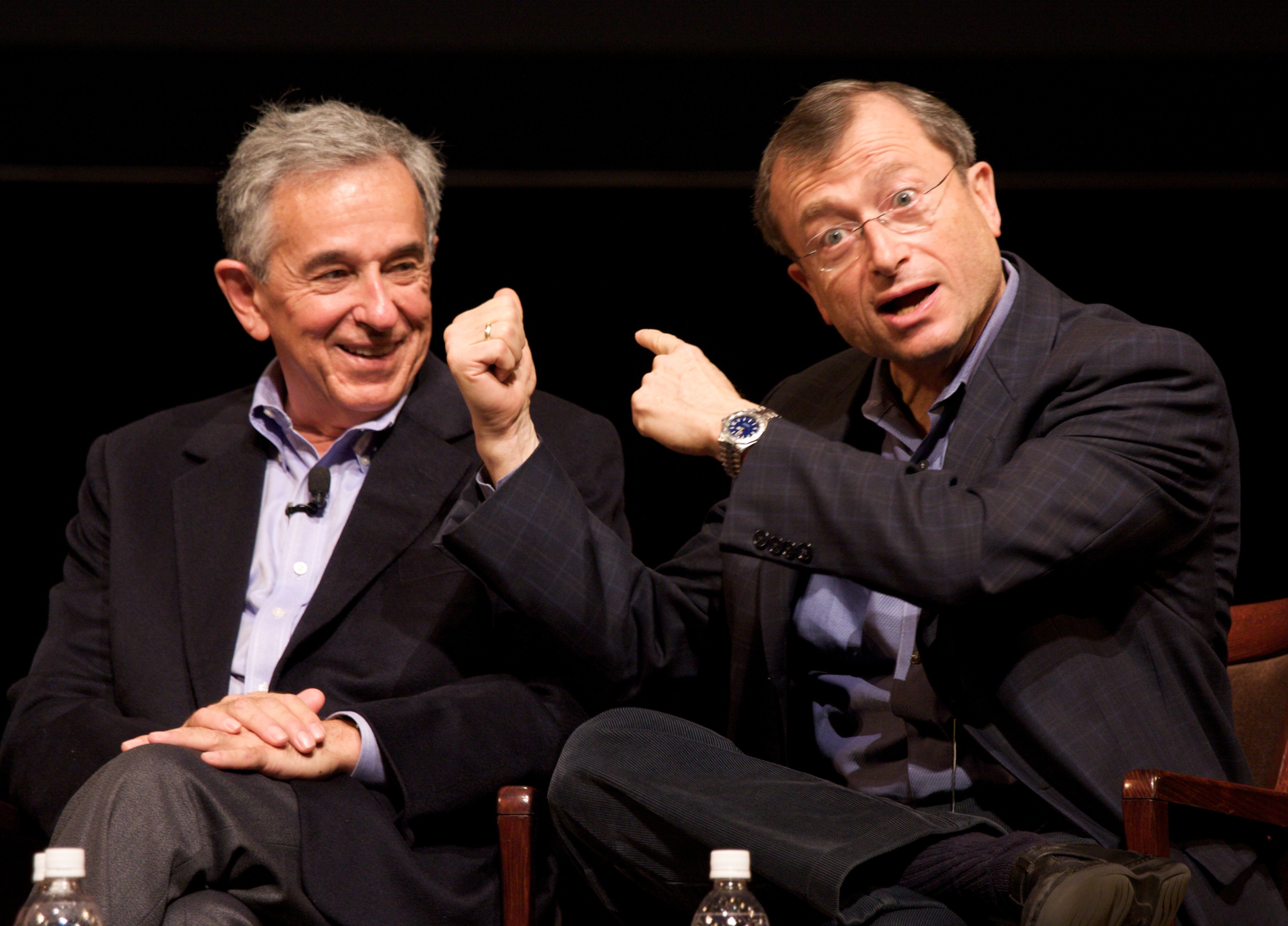|
Hypertext Editing System
The Hypertext Editing System, or HES, was an early hypertext research project conducted at Brown University in 1967 by Andries van Dam, Ted Nelson, and several Brown students.Brown University Department of Computer Science. (23 May 2019)A Half-Century of Hypertext at Brown It was the first hypertext system available on commercial equipment that novices could use. HES organized data into two main types: links and branching text. The branching text could automatically be arranged into menus, and a point within a given area could also have an assigned name, called a label, and be accessed later by that name from the screen. Although HES pioneered many modern hypertext concepts, its emphasis was on text formatting and printing. HES required an IBM 2250 display console and a large memory partition on Brown's IBM System/360 Model 50 campus mainframe computer which limited its use: "Although it was shared with others, it was a multi-million-dollar piece of technology housed in a large ... [...More Info...] [...Related Items...] OR: [Wikipedia] [Google] [Baidu] |
Hypertext
Hypertext is E-text, text displayed on a computer display or other electronic devices with references (hyperlinks) to other text that the reader can immediately access. Hypertext documents are interconnected by hyperlinks, which are typically activated by a mouse (computing), mouse click, keypress set, or screen touch. Apart from text, the term "hypertext" is also sometimes used to describe tables, images, and other presentational content formats with integrated hyperlinks. Hypertext is one of the key underlying concepts of the World Wide Web, where Web pages are often written in the Hypertext Markup Language (HTML). As implemented on the Web, hypertext enables the easy-to-use publication of information over the Internet. Etymology The English prefix "hyper-" comes from the Greek language, Greek prefix "ὑπερ-" and means "over" or "beyond"; it has a common origin with the prefix "super-" which comes from Latin. It signifies the overcoming of the previous linear cons ... [...More Info...] [...Related Items...] OR: [Wikipedia] [Google] [Baidu] |
Brown University
Brown University is a Private university, private Ivy League research university in Providence, Rhode Island, United States. It is the List of colonial colleges, seventh-oldest institution of higher education in the US, founded in 1764 as the ''College in the English Colony of Rhode Island and Providence Plantations''. One of nine colonial colleges chartered before the American Revolution, it was the first US college to codify that admission and instruction of students was to be equal regardless of the religious affiliation of students. The university is home to the oldest applied mathematics program in the country and oldest engineering program in the Ivy League. It was one of the early doctoral-granting institutions in the U.S., adding masters and doctoral studies in 1887. In 1969, it adopted its Open Curriculum (Brown University), Open Curriculum after student lobbying, which eliminated mandatory Curriculum#Core curriculum, general education distribution requirements. In 197 ... [...More Info...] [...Related Items...] OR: [Wikipedia] [Google] [Baidu] |
Andries Van Dam
Andries "Andy" van Dam (born December 8, 1938) is a Dutch-American professor of computer science and former vice-president for research at Brown University in Providence, Rhode Island. Together with Ted Nelson he contributed to the first hypertext system, Hypertext Editing System (HES) in the late 1960s. He co-authored '' Computer Graphics: Principles and Practice'' along with J.D. Foley, S.K. Feiner, and John Hughes. He also co-founded the precursor of the ACM SIGGRAPH conference. Van Dam serves on several technical boards and committees. He teaches an introductory course in computer science and courses in computer graphics at Brown University. Van Dam received his B.S. degree with Honors in Engineering Sciences from Swarthmore College in 1960 and his M.S. and Ph.D. from the University of Pennsylvania in 1963 and 1966, respectively. Students Van Dam has mentored undergraduates, other scholars, and practitioners in hypertext and computer graphics. One of his students was ... [...More Info...] [...Related Items...] OR: [Wikipedia] [Google] [Baidu] |
Ted Nelson
Theodor Holm Nelson (born June 17, 1937) is an American pioneer of information technology, philosopher, and sociologist. He coined the terms ''hypertext'' and ''hypermedia'' in 1963 and published them in 1965. According to his 1997 ''Forbes'' profile, Nelson "sees himself as a literary romantic, like a Cyrano de Bergerac, or 'the Orson Welles of software'." Early life and education Nelson is the son of Emmy Awards, Emmy Award–winning director Ralph Nelson and Academy Awards, AcademyAwardwinning actress Celeste Holm. His parents' marriage was brief and he was mostly raised by his grandparents, first in Chicago and later in Greenwich Village. Nelson earned a Bachelor of Arts, B.A. in philosophy from Swarthmore College in 1959. Following a year of graduate study in sociology at the University of Chicago, Nelson began graduate work in Social Relations, then a department at Harvard University, specializing in sociology, and ultimately earned a M.A in sociology from the Departmen ... [...More Info...] [...Related Items...] OR: [Wikipedia] [Google] [Baidu] |
IBM 2250
The IBM 2250 Graphics Display Unit was a vector graphics display system by IBM for the System/360; the Model IV attached to the IBM 1130. Overview The IBM 2250 Graphics Display Unit was announced with System/360 in 1964. A complete 2250 III system with controller cost around $280,000 in 1970, though up to 4 displays could share a single controller, reducing the cost per display by up to 40%. A display list of line segments (vector (geometric), vectors) on a 1024 by 1024 grid was stored in computer's memory or an optional buffer on the 2250 and repainted on the 2250's cathode-ray tube, CRT up to 40 times per second. The computer altered the display by changing the display list. Characters were built of line segments specified by display list subroutines. Thus any character set or typeface, font could be displayed, although fonts were generally extremely simplified for performance reasons. An optional character-generator feature on all models provided predefined fonts of 63 charac ... [...More Info...] [...Related Items...] OR: [Wikipedia] [Google] [Baidu] |
IBM System/360 Model 50
The IBM System/360 Model 50 is a member of the IBM System/360 family of computers. The Model 50 was announced in April 1964 with the other initial models of the family, and first shipped in August 1965 to the Bank of America. Models There are four models of the 360/50. They vary by the amount of core memory with which the system is offered. The F50, or 2050F is equipped with 65,536 bytes, the G50 has 131,072 bytes, the H50 262,144 bytes, and the I50 524,288 bytes. The system can also attach IBM 2361 Large Capacity Storage (LCS) modules which provide up to 8,388,608 bytes of additional storage, however with a considerably slower memory cycle time of 8 microseconds compared to the 2 microseconds of processor storage. Relative performance The system has a CPU cycle time of 500 nanoseconds, 25% faster than the Model 40 and 40% of the speed of the Model 65 which has a 200 nanosecond cycle time. Processor storage is magnetic core memory that transfers four bytes per 2 microsecond c ... [...More Info...] [...Related Items...] OR: [Wikipedia] [Google] [Baidu] |
Mainframe Computer
A mainframe computer, informally called a mainframe or big iron, is a computer used primarily by large organizations for critical applications like bulk data processing for tasks such as censuses, industry and consumer statistics, enterprise resource planning, and large-scale transaction processing. A mainframe computer is large but not as large as a supercomputer and has more processing power than some other classes of computers, such as minicomputers, server (computing), servers, workstations, and personal computers. Most large-scale computer-system architectures were established in the 1960s, but they continue to evolve. Mainframe computers are often used as servers. The term ''mainframe'' was derived from the large cabinet, called a ''main frame'', that housed the central processing unit and main computer memory, memory of early computers. Later, the term ''mainframe'' was used to distinguish high-end commercial computers from less powerful machines. Design Modern mainfr ... [...More Info...] [...Related Items...] OR: [Wikipedia] [Google] [Baidu] |
NASA
The National Aeronautics and Space Administration (NASA ) is an independent agencies of the United States government, independent agency of the federal government of the United States, US federal government responsible for the United States's civil list of government space agencies, space program, aeronautics research and outer space, space research. National Aeronautics and Space Act, Established in 1958, it succeeded the National Advisory Committee for Aeronautics (NACA) to give the American space development effort a distinct civilian orientation, emphasizing peaceful applications in space science. It has since led most of America's space exploration programs, including Project Mercury, Project Gemini, the 1968–1972 Apollo program missions, the Skylab space station, and the Space Shuttle. Currently, NASA supports the International Space Station (ISS) along with the Commercial Crew Program and oversees the development of the Orion (spacecraft), Orion spacecraft and the Sp ... [...More Info...] [...Related Items...] OR: [Wikipedia] [Google] [Baidu] |
Apollo Program
The Apollo program, also known as Project Apollo, was the United States human spaceflight program led by NASA, which Moon landing, landed the first humans on the Moon in 1969. Apollo followed Project Mercury that put the first Americans in space. It was conceived in 1960 as a three-person spacecraft during President Presidency of Dwight D. Eisenhower, Dwight D. Eisenhower's administration. Apollo was later dedicated to President John F. Kennedy's national goal for the 1960s of "landing a man on the Moon and returning him safely to the Earth" in an address to United States Congress, Congress on May 25, 1961. It was the third American human spaceflight program to fly, preceded by Project Gemini conceived in 1961 to extend spaceflight capability in support of Apollo. Kennedy's goal was accomplished on the Apollo 11 mission when astronauts Neil Armstrong and Buzz Aldrin landed their Apollo Lunar Module (LM) on July 20, 1969, and walked on the lunar surface, while Michael Collins ( ... [...More Info...] [...Related Items...] OR: [Wikipedia] [Google] [Baidu] |
Communications Of The ACM
''Communications of the ACM'' (''CACM'') is the monthly journal of the Association for Computing Machinery (ACM). History It was established in 1958, with Saul Rosen as its first managing editor. It is sent to all ACM members. Articles are intended for readers with backgrounds in all areas of computer science and information systems. The focus is on the practical implications of advances in information technology and associated management issues; ACM also publishes a variety of more theoretical journals. The magazine straddles the boundary of a science magazine, trade magazine, and a scientific journal. While the content is subject to peer review, the articles published are often summaries of research that may also be published elsewhere. Material published must be accessible and relevant to a broad readership. From 1960 onward, ''CACM'' also published algorithms, expressed in ALGOL. The collection of algorithms later became known as the Collected Algorithms of the ACM. CA ... [...More Info...] [...Related Items...] OR: [Wikipedia] [Google] [Baidu] |
File Retrieval And Editing System
The File Retrieval and Editing SyStem, or FRESS, was a hypertext system developed at Brown University starting in 1968 by Andries van Dam and his students, including Bob Wallace (computer scientist), Bob Wallace. It was the first hypertext system to run on readily available commercial hardware and OS. It is also possibly the first computer-based system to have had an "undo" feature for quickly correcting small editing or navigational mistakes. Features FRESS was a continuation of work done on van Dam's previous hypertext system, Hypertext Editing System, HES, developed the previous year. FRESS ran on an IBM 360-series mainframe running VM/CMS. It improved on HES's capabilities in many ways, inspired by Douglas Engelbart's NLS (computer system), NLS. FRESS implemented one of the first virtual terminal interfaces, in order to provide device-independence. It could run on various terminals from dumb typewriters up to the Imlac PDS-1 graphical minicomputer. On the PDS-1, it suppo ... [...More Info...] [...Related Items...] OR: [Wikipedia] [Google] [Baidu] |





